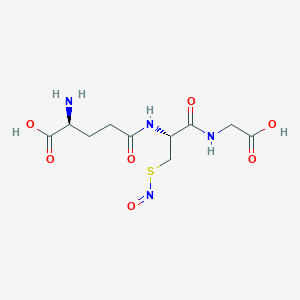|
S-Nitrosoglutathione is a S-nitrosothiol. S-nitrosothiols (RSNOs) are thought to represent a circulating endogenous reservoir of nitric oxide (NO), and may have potential as donors of nitric oxide, distinct from currently used agents. They have the general formula RSNO, and naturally occurring examples include S-nitrosocysteine, S-nitrosoglutathione and S-nitrosoalbumin, in which R is an amino acid, polypeptide and protein respectively. RSNOs have anti-platelet properties, a theoretical role in the treatment of asthma and the potential to be used as agents to treat infectious diseases ranging from the common cold to AIDS. RSNOs are relatively unstable, being degraded to release nitric oxide and the corresponding disulphide. Their stability is influenced by the properties of the R group, heat, light, the presence of transition metal ions (in particular copper) and the presence of other thiols. RSNOs participate in transnitrosation reactions in which the -nitric oxide group is transferred to another thiol to form a more stable RSNO. Potential interactions of RSNOs include that with ascorbic acid (vitamin C), which enhances the ability of copper to catalyse their degradation. Transnitrosation reactions with thiol-containing enzymes can influence protein function, and the intracellular thiol glutathione, levels of which are influenced by many disease states, can also influence stability. Genetic and biochemical data demonstrate a pivotal role for S-nitrosothiols in mediating the actions of nitric oxide synthases (NOSs). RSNOs serve to convey NO bioactivity and to regulate protein function. S-Nitrosoglutathione breakdown is subject to precise regulation. For example, S-Nitrosoglutathione reductase (GSNOR) breaks down cytosolic S-Nitrosoglutathione, ultimately to oxidized GSH and ammonia. GSNOR, in turn, modulates the levels of some S-nitrosylated proteins. S-nitrosoglutathione, formed as nitric oxide moves away from erythrocytes in response to hemoglobin desaturation, may signal hypoxia-inducible factor-1-mediated physiologic and gene regulatory events in pulmonary endothelial cells without profound hypoxia, through a thiol-based reaction. S-Nitrosoglutathione stabilizes the alpha-subunit of hypoxia inducible factor1 (HIF-1) in normoxic cells, but not in the presence of PI3K inhibitors.
|
 click to show the details of this protein
click to show the details of this protein
 click to show the details of experiment for validating this pair
click to show the details of experiment for validating this pair
 click to show the details of experiment for validating this pair
click to show the details of experiment for validating this pair

